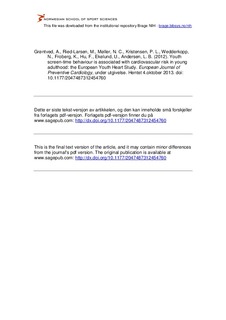| dc.contributor.author | Grøntved, Anders | |
| dc.contributor.author | Ried-Larsen, Mathias | |
| dc.contributor.author | Møller, Niels C. | |
| dc.contributor.author | Kristensen, Peter Lund | |
| dc.contributor.author | Wedderkopp, Niels | |
| dc.contributor.author | Froberg, Karsten | |
| dc.contributor.author | Hu, Frank B. | |
| dc.contributor.author | Ekelund, Ulf | |
| dc.contributor.author | Andersen, Lars Bo | |
| dc.date.accessioned | 2013-10-04T08:41:12Z | |
| dc.date.available | 2013-10-04T08:41:12Z | |
| dc.date.issued | 2012-07-05 | |
| dc.identifier | Seksjon for idrettsmedisinske fag / Department of Sports Medicine | |
| dc.identifier.citation | European journal of preventive cardiology. 2012 | no_NO |
| dc.identifier.issn | 2047-4881 | |
| dc.identifier.issn | 2047-4881 | |
| dc.identifier.uri | http://hdl.handle.net/11250/171190 | |
| dc.description | I Brage finner du siste tekst-versjon av artikkelen, og den kan inneholde ubetydelige forskjeller fra forlagets pdf-versjon. Forlagets pdf-versjon finner du på www.sagepub.com: http://dx.doi.org/10.1177/2047487312454760 / In Brage you'll find the final text version of the article, and it may contain insignificant differences from the journal's pdf version. The original publication is available at www.sagepub.com: http://dx.doi.org/10.1177/2047487312454760 | no_NO |
| dc.description.abstract | Aims: We prospectively examined the association of TV viewing, computer use, and total screen time in adolescence, and change in these behaviours, with cardiovascular disease (CVD) risk factors in young adulthood.
Methods and results: This was a prospective cohort study among Danish men and women (n = 435) followed for up to 12 years. Adiposity, blood pressure (BP), triglycerides, high-density lipoprotein (HDL), glucose, insulin, and self-reported TV viewing and computer use were obtained in adolescence and in young adulthood. A continuous metabolic syndrome z-score was calculated as the sum of standardized values of each risk factor (inverse of HDL). In multivariable-adjusted analyses, TV viewing and total screen time in adolescence were positively associated with adiposity, triglycerides, and metabolic syndrome z-score in young adulthood (p < 0.05). Individuals who increased their TV viewing, computer use, or total screen time with more than 2 hours/day from adolescence to young adulthood had 0.90 (95% CI 0.12 to 1.69), 0.95 (95% CI 0.01 to 1.88), and 1.40 (95% CI 0.28 to 2.51) kg/m2 higher body mass index, respectively, in young adulthood compared with individuals who remained stable or decreased their viewing time. Insulin and metabolic syndrome z-scores were also higher among individuals who increased their TV viewing, computer use, or total screen time more than 2 hours/day compared with individuals who remained stable or decreased their viewing time (p < 0.05).
Conclusions: Prolonged TV viewing and total screen time during leisure time in adolescence, and increases in these behaviours, are associated with unfavourable levels of several cardiovascular risk factors in young adulthood. | no_NO |
| dc.language.iso | eng | no_NO |
| dc.publisher | SAGE | no_NO |
| dc.subject | adiposity | |
| dc.subject | adolescent behavior | |
| dc.subject | age factors | |
| dc.subject | blood glucose / analysis | |
| dc.subject | blood pressure | |
| dc.subject | body mass index | |
| dc.subject | cardiovascular diseases / epidemiology | |
| dc.subject | cardiovascular diseases / prevention & control | |
| dc.subject | computers | |
| dc.subject | Europe / epidemiology | |
| dc.subject | health behavior | |
| dc.subject | health knowledge, attitudes, practice | |
| dc.subject | insulin / blood | |
| dc.subject | linear models | |
| dc.subject | lipids / blood | |
| dc.subject | metabolic syndrome X / blood | |
| dc.subject | metabolic syndrome X / diagnosis | |
| dc.subject | metabolic syndrome X / epidemiology | |
| dc.subject | multivariate analysis | |
| dc.subject | obesity / blood | |
| dc.subject | obesity / diagnosis | |
| dc.subject | obesity / epidemiology | |
| dc.subject | obesity / prevention & control | |
| dc.subject | prospective studies | |
| dc.subject | risk factors | |
| dc.subject | risk redundant behavior | |
| dc.subject | sedentary lifestyle | |
| dc.subject | television | |
| dc.subject | time factors | |
| dc.title | Youth screen-time behaviour is associated with cardiovascular risk in young adulthood: The European Youth Heart Study | no_NO |
| dc.type | Journal article | no_NO |
| dc.type | Peer reviewed | no_NO |
| dc.subject.nsi | VDP::Medical disciplines: 700::Clinical medical disciplines: 750::Cardiology: 771 | no_NO |
| dc.subject.nsi | VDP::Medical disciplines: 700::Clinical medical disciplines: 750::Vascular and thoracic surgery: 782 | no_NO |
| dc.source.journal | European journal of preventive cardiology | |
| dc.identifier.doi | 10.1177/2047487312454760 | |
